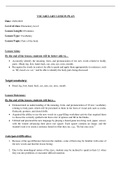VOCABULARY LESSON PLAN
Date: 15/01/2023
Level of class: Elementary Level
Lesson Length: 60 minutes
Lesson Type: Vocabulary
Lesson Topic: Parts of the body
Lesson Aims:
By the end of the lesson, students will be better able to…
Accurately identify the meaning, form, and pronunciation of ten new words related to bodily
parts. (Head, leg, foot, hand, back, ear, arm, eye, nose, mouth).
Recognize the words in context, be able to speak and apply them appropriately in sentences, such
as "My hands are wet," and be able to identify the body parts being discussed.
Target vocabulary:
Head, leg, foot, hand, back, ear, arm, eye, nose, mouth
Lesson Outcomes:
By the end of the lesson, students will have…
Demonstrated an understanding of the meaning, form, and pronunciation of 10 new vocabulary
relating to body parts which will be presented to them in the form of visual aids such as realia,
flashcard, gestures, and choral drills.
Acquired the ability to use the new words in a gap-filling worksheet activity that required them
to choose the correctly spelled term from a list of options and fill in the blanks.
Utilized and practiced the new language by playing a board game involving rock, paper, scissor,
with the winner advancing their piece one square. Each square contains an image, and the
student's task is to create a sentence based on what they see. e.g., “He has nice eyes.”
Anticipated difficulties:
1. Because of the age difference between the students, some of them may be familiar with some of
the new words and find the lesson boring.
2. Due to the monolingual nature of the class, students may be inclined to speak in their L1 when
they run into problems or encounter difficult material.
, 3. The English consonants /l/ and /r/ pose a unique challenge for Chinese learners. This is so
because these sounds do not directly match to any sounds in Chinese. Chinese learners may
have problems pronouncing terms like "ear" and "legs" because they are unable to distinguish
between the two sounds, which makes it difficult for them to learn.
4. Due to the predominance of men in this class, some female students may feel intimidated and
lack the confidence to speak in front of their peers, which may lead to participation issues.
Suggested solutions:
1. Assign students to groups of mixed ages or pair them up, and make sure each group member has
a task to complete. Asking older students to peer tutor the class's younger students can also be a
good way to keep things interesting. Being role models can boost one's self-esteem and make one
feel more mature.
2. At the start of the lesson, establish a set of rules, one of which is that students are expected to
speak only English, and explain to them why this is beneficial to their language learning. Remind
students respectfully and kindly if they start using their L1 again.
3. You can assist your students with this by demonstrating to them physically how various sounds
are produced and by having them listen to minimal pairs of sounds to help train their ears. Playing
games that incorporate both sounds would be beneficial as well. Give students plenty of time to
practice the correct pronunciation after you have modelled it for them
5. At the outset of the lesson, remind the students that making errors is an integral part of the
language acquisition process. If a student makes a mistake, the teacher will write it down and
discuss it with the class or individually. This should boost student confidence and keep any
student from being singled out. Using whole-class teaching can assist in eliminating barriers
between male and female students. Encouraging collaboration helps to break the ice and eliminate
gender prejudice in the classroom.




